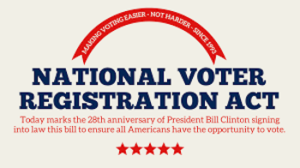
*On January 1, 1995, The National Voter Registration Act of 1993 (NVRA) went into effect. Also known as the Motor Voter Act, it was a United States federal law signed on May 20, 1993.
After Congress enacted the Voting Rights Act of 1965 to address rampant voting discrimination against racial minorities, voting rights advocates argued for federal legislation to remove other barriers to voter registration in the United States. The basic requirements to vote are the same in all states. A person must be a U.S. citizen, at least 18 years old, and a resident of the state where they vote. However, initial legislative efforts failed to create national voter registration standards for federal elections.
In the early 1970s, Congress considered several proposals to require the U.S. Census Bureau to mail voter registration forms to every household, none of which passed. In the mid and late 1970s, proposals to require certain public agency offices to make voter registration forms available and to require states to allow Election Day voter registration (EDR) failed. Other bills introduced during the 1980s also failed. Congress passed two pieces of legislation in the 1980s that made voter registration for federal elections more accessible for specific disadvantaged populations.
The Voting Accessibility for the Elderly and Handicapped Act of 1984 requires states to make "a reasonable number of accessible permanent registration facilities" and registration aids available to elderly and disabled voters. The Uniformed and Overseas Citizens Absentee Voting Act of 1986 requires states to mail federal voter registration forms to overseas and military voters and permit them to register by mail. In light of low voter turnout in federal elections in the 1980s, Congress returned its attention to creating general voter registration standards in the late 1980s and early 1990s.
Members of Congress introduced a series of "motor voter" bills to require state motor vehicle agencies to offer voter registration opportunities to persons applying for a driver's license. The first of these bills, the proposed National Voter Registration Act of 1989, passed in the House of Representatives with bipartisan support but failed to pass in the Senate. A similar bill in 1991 gained less bipartisan support; it passed in both the Senate and the House but was vetoed by President George H.W. Bush. Two years later, Congress passed a nearly identical bill: the National Voter Registration Act of 1993.
The law was enacted under the Elections Clause of the United States Constitution and advances voting rights in the United States by requiring state governments to offer simplified voter registration processes for any eligible person who applies for or renews a driver's license or applies for public assistance and requiring the United States Postal Service to mail election materials of a state as if the state is a nonprofit. The law requires states to register applicants using a federal voter registration form and prohibits states from removing registered voters from the voters unless specific criteria are met.
The act exempts states from its requirements that have continuously, since August 1, 1994, not required voter registration for federal elections or offered election day registration (EDR) for federal general elections. Six states qualify for the exemption: North Dakota, which does not require registration, while Idaho, Minnesota, New Hampshire, Wisconsin, and Wyoming because of the EDR exemption. Maine lost the exemption when it abolished EDR in 2011, although EDR was restored in that state.